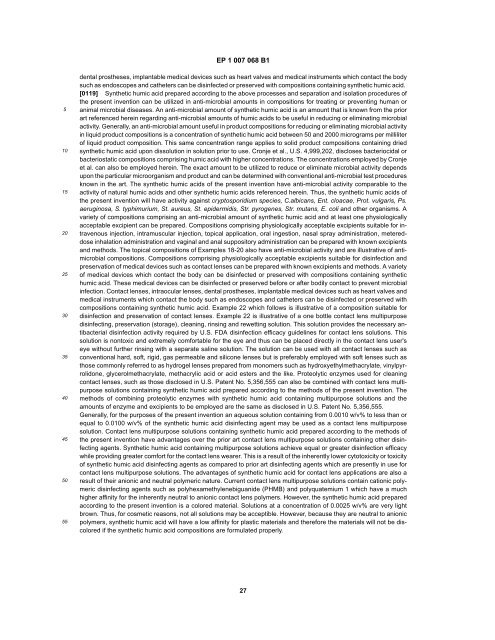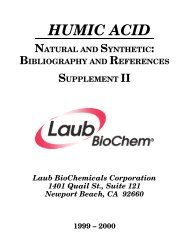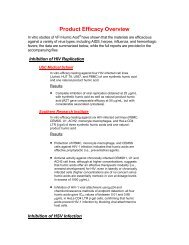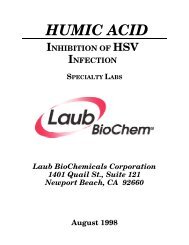HUMIC ACID - Laub BioChem
HUMIC ACID - Laub BioChem
HUMIC ACID - Laub BioChem
- No tags were found...
You also want an ePaper? Increase the reach of your titles
YUMPU automatically turns print PDFs into web optimized ePapers that Google loves.
EP 1 007 068 B1510152025303540455055dental prostheses, implantable medical devices such as heart valves and medical instruments which contact the bodysuch as endoscopes and catheters can be disinfected or preserved with compositions containing synthetic humic acid.[0119] Synthetic humic acid prepared according to the above processes and separation and isolation procedures ofthe present invention can be utilized in anti-microbial amounts in compositions for treating or preventing human oranimal microbial diseases. An anti-microbial amount of synthetic humic acid is an amount that is known from the priorart referenced herein regarding anti-microbial amounts of humic acids to be useful in reducing or eliminating microbialactivity. Generally, an anti-microbial amount useful in product compositions for reducing or eliminating microbial activityin liquid product compositions is a concentration of synthetic humic acid between 50 and 2000 micrograms per milliliterof liquid product composition. This same concentration range applies to solid product compositions containing driedsynthetic humic acid upon dissolution in solution prior to use. Cronje et al., U.S. 4,999,202, discloses bacteriocidal orbacteriostatic compositions comprising humic acid with higher concentrations. The concentrations employed by Cronjeet al. can also be employed herein. The exact amount to be utilized to reduce or eliminate microbial activity dependsupon the particular microorganism and product and can be determined with conventional anti-microbial test proceduresknown in the art. The synthetic humic acids of the present invention have anti-microbial activity comparable to theactivity of natural humic acids and other synthetic humic acids referenced herein. Thus, the synthetic humic acids ofthe present invention will have activity against cryptosporidium species, C.albicans, Ent. cloacae, Prot. vulgaris, Ps.aeruginosa, S. typhimurium, St. aureus, St. epidermidis, Str. pyrogenes, Str. mutans, E. coli and other organisms. Avariety of compositions comprising an anti-microbial amount of synthetic humic acid and at least one physiologicallyacceptable excipient can be prepared. Compositions comprising physiologically acceptable excipients suitable for intravenousinjection, intramuscular injection, topical application, oral ingestion, nasal spray administration, metereddoseinhalation administration and vaginal and anal suppository administration can be prepared with known excipientsand methods. The topical compositions of Examples 18-20 also have anti-microbial activity and are illustrative of antimicrobialcompositions. Compositions comprising physiologically acceptable excipients suitable for disinfection andpreservation of medical devices such as contact lenses can be prepared with known excipients and methods. A varietyof medical devices which contact the body can be disinfected or preserved with compositions containing synthetichumic acid. These medical devices can be disinfected or preserved before or after bodily contact to prevent microbialinfection. Contact lenses, intraocular lenses, dental prostheses, implantable medical devices such as heart valves andmedical instruments which contact the body such as endoscopes and catheters can be disinfected or preserved withcompositions containing synthetic humic acid. Example 22 which follows is illustrative of a composition suitable fordisinfection and preservation of contact lenses. Example 22 is illustrative of a one bottle contact lens multipurposedisinfecting, preservation (storage), cleaning, rinsing and rewetting solution. This solution provides the necessary antibacterialdisinfection activity required by U.S. FDA disinfection efficacy guidelines for contact lens solutions. Thissolution is nontoxic and extremely comfortable for the eye and thus can be placed directly in the contact lens user'seye without further rinsing with a separate saline solution. The solution can be used with all contact lenses such asconventional hard, soft, rigid, gas permeable and silicone lenses but is preferably employed with soft lenses such asthose commonly referred to as hydrogel lenses prepared from monomers such as hydroxyethylmethacrylate, vinylpyrrolidone,glycerolmethacrylate, methacrylic acid or acid esters and the like. Proteolytic enzymes used for cleaningcontact lenses, such as those disclosed in U.S. Patent No. 5,356,555 can also be combined with contact lens multipurposesolutions containing synthetic humic acid prepared according to the methods of the present invention. Themethods of combining proteolytic enzymes with synthetic humic acid containing multipurpose solutions and theamounts of enzyme and excipients to be employed are the same as disclosed in U.S. Patent No. 5,356,555.Generally, for the purposes of the present invention an aqueous solution containing from 0.0010 w/v% to less than orequal to 0.0100 w/v% of the synthetic humic acid disinfecting agent may be used as a contact lens multipurposesolution. Contact lens multipurpose solutions containing synthetic humic acid prepared according to the methods ofthe present invention have advantages over the prior art contact lens multipurpose solutions containing other disinfectingagents. Synthetic humic acid containing multipurpose solutions achieve equal or greater disinfection efficacywhile providing greater comfort for the contact lens wearer. This is a result of the inherently lower cytotoxicity or toxicityof synthetic humic acid disinfecting agents as compared to prior art disinfecting agents which are presently in use forcontact lens multipurpose solutions. The advantages of synthetic humic acid for contact lens applications are also aresult of their anionic and neutral polymeric nature. Current contact lens multipurpose solutions contain cationic polymericdisinfecting agents such as polyhexamethylenebiguanide (PHMB) and polyquatemium 1 which have a muchhigher affinity for the inherently neutral to anionic contact lens polymers. However, the synthetic humic acid preparedaccording to the present invention is a colored material. Solutions at a concentration of 0.0025 w/v% are very lightbrown. Thus, for cosmetic reasons, not all solutions may be acceptible. However, because they are neutral to anionicpolymers, synthetic humic acid will have a low affinity for plastic materials and therefore the materials will not be discoloredif the synthetic humic acid compositions are formulated properly.27










